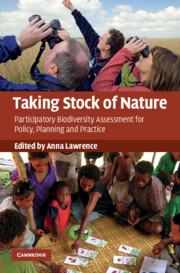Book contents
- Frontmatter
- Contents
- List of contributors
- Acknowledgements
- 1 Introduction: learning from experiences of participatory biodiversity assessment
- 2 Monitoring and assessment of biodiversity under the Convention on Biological Diversity and other international agreements
- 3 The Millennium Ecosystem Assessment: a multi-scale assessment for global stakeholders
- 4 Conservation of biological diversity in El Salvador shade coffee: the importance of taxonomic capacity for participatory assessments
- 5 Taking stock of nature in species-rich but economically poor areas: an emerging discipline of locally based monitoring
- 6 Researching local perspectives on biodiversity in tropical landscapes: lessons from ten case studies
- 7 Participatory resources monitoring in SW China: lessons after five years
- 8 Forest inventory in Nepal – technical power or social empowerment?
- 9 Perceptions of landscape change in British Columbia's Northwest: implications for biodiversity and participatory management
- 10 How thousands planned for a billion: lessons from India on decentralized, participatory planning
- 11 Inside monitoring: a comparison of bird monitoring groups in Slovenia and the United Kingdom
- 12 The personal and political of volunteers' data: towards a national biodiversity database for the UK
- 13 Improving forest management through participatory monitoring: a comparative case study of four community-based forestry organizations in the Western United States
- Index
- References
5 - Taking stock of nature in species-rich but economically poor areas: an emerging discipline of locally based monitoring
Published online by Cambridge University Press: 06 December 2010
- Frontmatter
- Contents
- List of contributors
- Acknowledgements
- 1 Introduction: learning from experiences of participatory biodiversity assessment
- 2 Monitoring and assessment of biodiversity under the Convention on Biological Diversity and other international agreements
- 3 The Millennium Ecosystem Assessment: a multi-scale assessment for global stakeholders
- 4 Conservation of biological diversity in El Salvador shade coffee: the importance of taxonomic capacity for participatory assessments
- 5 Taking stock of nature in species-rich but economically poor areas: an emerging discipline of locally based monitoring
- 6 Researching local perspectives on biodiversity in tropical landscapes: lessons from ten case studies
- 7 Participatory resources monitoring in SW China: lessons after five years
- 8 Forest inventory in Nepal – technical power or social empowerment?
- 9 Perceptions of landscape change in British Columbia's Northwest: implications for biodiversity and participatory management
- 10 How thousands planned for a billion: lessons from India on decentralized, participatory planning
- 11 Inside monitoring: a comparison of bird monitoring groups in Slovenia and the United Kingdom
- 12 The personal and political of volunteers' data: towards a national biodiversity database for the UK
- 13 Improving forest management through participatory monitoring: a comparative case study of four community-based forestry organizations in the Western United States
- Index
- References
Summary
Introduction
Conventional scientist-executed forms of monitoring are expensive and rely upon highly skilled scientists or technicians (Danielsen et al., 2000). As such only a small amount of this type of monitoring is undertaken in developing countries, where funding and available expertise are limited. This is unfortunate as the developing countries have the greatest importance globally in terms of their assemblages of species, including those threatened by extinction, and also have a great diversity of habitats and important ecosystem services (Millenium Ecosystem Assessment, 2005). They are also the parts of the world where habitat loss is currently proceeding at the greatest speed, and where we know least about the trends in species abundance (Balmford, Green and Jenkins, 2003; IUCN, 2007).
Recently, experiments have been made to involve less educated local people in monitoring of natural resources in developing countries. Although there are still a number of scientific questions surrounding these approaches, and many schemes are still at an early stage of development, the new approaches show a great deal of promise (Danielsen, Burgess and Balmford, 2005a; Danielsen, Burgess and Balmford, 2005c). This chapter analyses the success and challenges of four schemes that stand out from the majority, because they have been replicated and scaled-up, and are now institutionalized and adopted nationally in the respective countries. We begin by describing and explaining the activities and outcomes for each of the four schemes, before presenting our own cross-cutting analysis of the benefits and challenges of such approaches.
- Type
- Chapter
- Information
- Taking Stock of NatureParticipatory Biodiversity Assessment for Policy, Planning and Practice, pp. 88 - 112Publisher: Cambridge University PressPrint publication year: 2010
References
- 6
- Cited by

